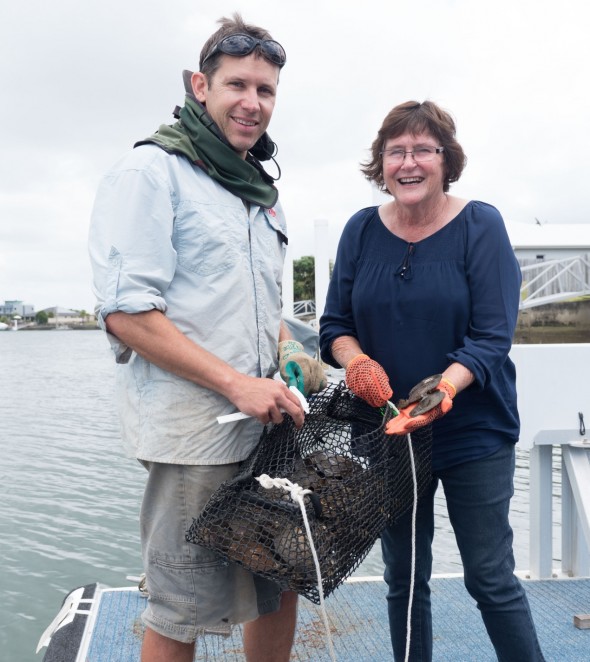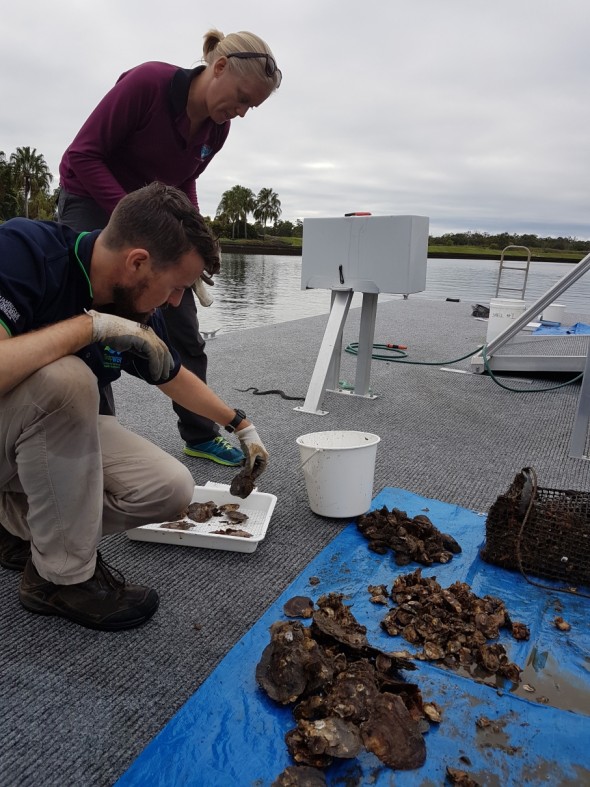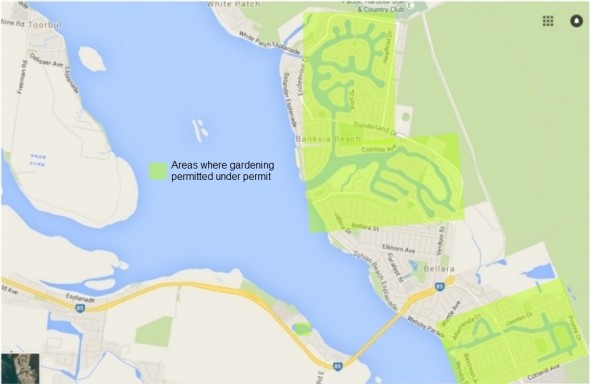In early 2016 we obtained funding from the Federal Government under its Landcare Program to develop Australia’s first community oyster gardening initative on Bribie Island. This was subsequently topped up with a Citizen Science Grant from the Office of the Queensland Chief Scientist. Oyster gardening is a great way to inform and educate the local community through active participation while generating a source of live shellfish for future reef restoration research.
An information evening was held on the 3rd August 2016 at Banksia Beach State School, Sunderland Drive, Banksia Beach. There a presentation was made informing around 60 prospective gardeners about the project and its wider context. Afterwards attendees got to chat together and meet their molluscs. Much interest was generated including an interview by 612 ABCs Spencer Howson on the breakfast show on 12 August 2016, which can be heard below:
Australia’s first oyster gardens began to be delivered in October 2016 and you can see and hear how the ABC tagged along for some of our deliveries here.

Delivering oyster gardens to gardeners began in October 2016.

ABC radio interviewing an oyster gardener.
Later in the growing season the good people from the TV program Scope dropped by, and their video can be seen on youtube here. Our gardeners have generated some interesting results and their observations have populated our Creature Feature1 , Creature Feature2 and Creature Feature3 newsletters as well as our Stonefish Alert. Researchers from James Cook University also dropped by to collect more data from our oyster gardens on invertebrate recruitment.

Researchers from James Cook University counting invertebrates from oyster gardens.
Those interested in what oyster gardening involves can download our Oyster Gardening Leaflet which is a handy guide to help people understand what oyster gardeners do. For those participating in the scheme (or for anyone interested in knowing more about local inhabitats of oyster reefs), you can download our Guide to Oyster Associates. Results from our first 6 months gardening can be found for Sydney rock oysters HERE, and for leaf oysters HERE. The final 12 month results can be obtained HERE for Sydney rock oysters and for leaf oysters HERE.
Summary data included: mean survival of Sydney rock oysters 80.5% (blue monoculture gardens) and 83.9% (community multispecies gardens), mean shell growth 14.1% (monoculture gardens) or 14.4% (community multispecies gardens), and average 260% increase in the total number of shellfish in gardens (12,000 shellfish deployed Nov 2016 , 30,000 shellfish collected Nov 2017). The community multispecies gardens were also more than twice as effective at recruiting finfish and invertebrates (mean 28 associates/basket for community gardens vs 12 associates/basket for monoculture gardens). These data suggest mixed species shellfish reefs should be constructed (not monocultures) to maximise shellfish growth, survival and reef productivity.
Our initial oyster gardening project was wound up in early December 2017 with deployment of around 30,000 oysters onto trial reefs in the Pumicestone Passage.

Gardened oysters deployed on an experimental shellfish reef in Pumicestone Passage.
Here is a video of one of the trial reefs freshly topped with live oyster gardened oysters, while this exciting video shows what the fish thought of the same reef, 9 months later. Sampling of invertebrates found exciting news that we had successful recruitment of juvenile oysters to the reefs.
The success of Australia’s first oyster gardening initiative is demonstrated by our results – the deployment of 30,000 oysters represents a 260% increase in oyster numbers based on natural recruitment over 12 months! Based on an average filtration rate of 4 L water/hr per oyster and a conservative average 300 oysters per bag, this also means each participating household filtered an estimated 58 tonnes of water per day through their oyster gardens! Thanks to all our gardeners and the community on Bribie for making the project a success, and thanks to funding from Landcare and an Engaging Science Grant from the Office of the Queensland Chief Scientist (see the Advance Queensland Website).
